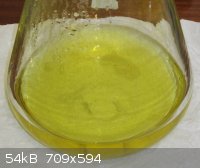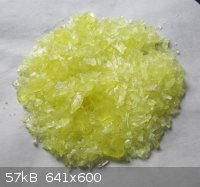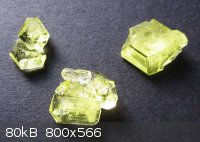AirCowPeaCock
Hazard to Others
  
Posts: 311
Registered: 9-1-2012
Location: In your nation!
Member Is Offline
Mood: Hazardous
|
|
sodium ferrocyanide?
Is their any reasonably easy way to produce sodium ferrocyanide? Preferably (but not necessarily) without a hydrogen cyanide intermediate.
BOLD
|
|
|
blogfast25
International Hazard
    
Posts: 10562
Registered: 3-2-2008
Location: Neverland
Member Is Offline
Mood: No Mood
|
|
Not really. Use the search facility to find threads on 'Ye Olde Wayes' of making these ferro/ferricyanides. Smelly business!
Or ask AJKOER, he might have something with bleach up his sleeve! 
[Edited on 26-1-2012 by blogfast25]
|
|
|
AirCowPeaCock
Hazard to Others
  
Posts: 311
Registered: 9-1-2012
Location: In your nation!
Member Is Offline
Mood: Hazardous
|
|
Looks like Ill just buy it--no fun.. 
BOLD
|
|
|
AirCowPeaCock
Hazard to Others
  
Posts: 311
Registered: 9-1-2012
Location: In your nation!
Member Is Offline
Mood: Hazardous
|
|
I came across a reference to a patent for production of cyanide salts on another thread.
https://www.sciencemadness.org/whisper/viewthread.php?tid=23
Its easy, apparently--but it makes me scared of my black powder 8-O
But even from there getting to ferrocyanide is gonna be inconvenient, and on top of that--I don't know if I trust my fume hood with hydrogen cyanide
gas--and my dad wouldn't be psyched about it either!
BOLD
|
|
|
Boffis
International Hazard
    
Posts: 1836
Registered: 1-5-2011
Member Is Offline
Mood: No Mood
|
|
Sodium Ferrocyanide preparation
As part of my experiments in the preparation of sodium cyanide from easily available sources I recently prepared sodium ferrocyanide from prussian
blue as follows;
Preparation of Sodium Cyanide via Sodium Ferrocyanide
As part of an investigation into the home production of sodium cyanide it was decided to investigate the use of cheap and readily available Prussian
blue pigment as a substitute for the now scarce blue billy from old gas works. The theoretical equation is:
Fe7(CN)18 + 12NaOH + 26H2O -> 3Na4Fe(CN)6(H2O)10 + 4FeO(OH)
Sodium Ferrocyanide from Prussian blue
73.4g of Prussian blue pigment in a 500ml beaker was wetted with a little methanol water mixture and then 100ml of water stirred into to produce a
thick slurry. 41g of sodium hydroxide was was dissolved in 100ml of water and while still warm added to the pigment slurry with vigorous stirring. A
fairly vigorous and slightly exothermic reaction set in (to my surprise), the slurry turned dark brown and a little ammonia was released. A further
50ml of cold water was added to cool the mixture and dilute the alkali. After the slurry had turned a homogenous reddish brown it was heated on a
hotplate to about 100°C for a few minutes and then filtered hot through a large Buchner funnel using gentle suction to minimise blinding of the
filter paper. The clear yellow filtrate was transferred to a 250ml beaker and left to cool.

Fig 1 Clear yellow sodium ferrocyanide solution
The soft cake was difficult to wash so was transferred to a blender and liquidised with 200ml of hot water and filtered again. This process was
repeated again to obtain a third filtrate. The second and third filtrates were combined and evaporated down to about 200ml and left to cool. The first
filtrate crystallised and large pale yellow glassy crystals 10-18mm across of the decahydrate formed. Both batches were cooled overnight in the fridge
and filtered on the same filter paper and then placed on a couple of large filter papers to drain and dry at room temperature: Yield 60.43g.
The combined filtrate was evaporated down to about 180ml and again cooled in the fridge to obtain a second crop of crystals; 30.18g. The filtrate was
again evaporated down but this time the resulting crystals were mostly colourless and not sodium ferrocyanide.

Fig 2. Sodium ferrocyanide crystals
The combined yield of sodium ferrocyanide was 90.62 g or 73% based on theoretically pure Prussian blue.
For sodium cyanide production the anhydrous salt is required so the salt was placed on a metal tray and dried in the oven at 120-130°C for about 2
hours to give 55.79g (71.63% yield based on Prussian blue) of off white opaque fragile anhydrous sodium ferrocyanide.

Fig 3. The best crystals of sodium ferrocyanide 10 hydrate
In my youth when there were many old gasworks site scattered oround my home we used to use "blue billy" which is an impure prussian blue that resulted
from the use of moist ferric oxide hydrate in the gas scrubber to remove hydrogen cyanide. The yield however was usually only 5-8% of theoretical and
the first filtrate a brownish colour. The best way to purify it was to make it very slightly acidic and fairly dilute and then precipitate the
ferrocyanide again with ferric chloride and then process the prussian blue that resulted as above.
I have yet to try the caustic soda-iron fillings-protein rich waste route, though I intend to try it soon.
|
|
|
woelen
Super Administrator
        
Posts: 7977
Registered: 20-8-2005
Location: Netherlands
Member Is Offline
Mood: interested
|
|
Are you sure this is pure sodium ferrocyanide and not a mix of sodium ferrocyanide and potassium ferrocyanide? I always had the impression that the
pigment prussion blue contains potassium ions as well and can better be described as KFeFe(CN)6.
The usual ferrocyanide salt is K4Fe(CN)6.3H2O and I can imagine that your product contains a lot of this as well.
[Edited on 19-4-13 by woelen]
|
|
|
Boffis
International Hazard
    
Posts: 1836
Registered: 1-5-2011
Member Is Offline
Mood: No Mood
|
|
The loss of weight on drying to the anhydrous salt was almost exactly theoretical for sodium ferrocyanide 10hydrate, any significant quantity of
potassium would reduce this figure significantly even if it were forced to crystallise as the 10 hydrate too. The yield of final product is quiet low
I had expected to get more than 90% but as I said above the 3rd crop of crystals was about half colourless crystals and reprocessing this I don't
think would yield more than another 10%. There was some release of ammonia which I had attributed to hydrolysis of the ferrocyanide ions in locally
very alkaline conditions caused by difficulty mixing the thick slurry quickly enough to prevent it. Ammonia is also evolved when you use blue billy.
You are right that Prussian blue can contain K. There is a potassium rich form known as "soluble" prussian blue but it is really colloidal making it
impossible to filter. It's formation is minimised by keeping the ferric ions in excess and this is important when making prussian blue commercially
hence commercial Prussian blue is generally low in K. More problematic is the presence of mechanical adulterants. The presence of the colourless
crystals suggests that other components are present but the product has the characteristics of fairly pure sodium ferrocyanide 10hydrate.
I will repeat the experiment some time and see if I can identify the colourless material. When using blue billy a significant amount of thiocyanate is
usually present and if potassium hydroxide is used the appropriate salt can crystallise with the ferrocyanide if evaporation is taken too far.
|
|
|
blogfast25
International Hazard
    
Posts: 10562
Registered: 3-2-2008
Location: Neverland
Member Is Offline
Mood: No Mood
|
|
This is quite an interesting way of making hexacyanoferrate (II). But I wouldn't describe Prussian Blue as 'cheap and readily available', at least not
down our way. I've had several people enquire about it and a few wanting to buy the precursors to it. Pity, as I'd have liked to make the potassium
version of it...  Both the II and the III versions are useful things to have in the
larder. Both the II and the III versions are useful things to have in the
larder.
|
|
|
Boffis
International Hazard
    
Posts: 1836
Registered: 1-5-2011
Member Is Offline
Mood: No Mood
|
|
25 pounds sterling for 1kg of prussian blue doesn't seem too bad. Google is an amazing beast sometimes and with only a little magic should transport
you to an emporium of the fanstaical! They even have Dragons blood!
|
|
|
elementcollector1
International Hazard
    
Posts: 2684
Registered: 28-12-2011
Location: The Known Universe
Member Is Offline
Mood: Molten
|
|
Huh. That explains why Professor Slughorn seems to have an endless supply for Potions class whenever I go. 
Elements Collected:52/87
Latest Acquired: Cl
Next in Line: Nd
|
|
|
woelen
Super Administrator
        
Posts: 7977
Registered: 20-8-2005
Location: Netherlands
Member Is Offline
Mood: interested
|
|
Strange that prussian blue is easier for you to obtain than the potassium ferrocyanides and ferricyanides. Where I live, the only affordable compounds
are the red salt K3Fe(CN)6 and the yellow salt K4Fe(CN)6.3H2O. I've never seen prussian blue at any seller in NL which I know. The red and yellow salt
are not really expensive. The red one is especially easy to obtain, because it is used in photography and still quite a few sellers sell this
compound.
The sodium salt I cannot easily buy. I also know a supplier of (NH4)4Fe(CN)6, but this salt is very expensive, more than EUR 1 per gram.
[Edited on 21-4-13 by woelen]
|
|
|
Boffis
International Hazard
    
Posts: 1836
Registered: 1-5-2011
Member Is Offline
Mood: No Mood
|
|
At the present moment there are at least 4 european suppliers of red K ferricyanide on ebay and 3 for yellow K ferrocyanide. The Polish supplier also
has (had) ammonium ferrocyanide though it isn't list at present and it wasn't that much more expensive. No sodium salts are being offered at present.
So there is no real point making the K salts. (By the way you can reduce red ferricyanide with alkali and iron powder and other reducing agents.
If you are making sodium cyanide from sodium (easily available on ebay too, though not cheap) and anhydrous sodium ferrocyanide you abviously need the
sodium salt. I do have somewhere a description of making the sodium salt from the potassium salt by differential crystallisation; I'll try and find it
and post it.
You can make a mixed cyanide from anhydrous K ferrocyanide and sodium too, it just makes the calculation more difficult!
|
|
|
blogfast25
International Hazard
    
Posts: 10562
Registered: 3-2-2008
Location: Neverland
Member Is Offline
Mood: No Mood
|
|
If you have a reference to it I'd be interested in that.
|
|
|
Boffis
International Hazard
    
Posts: 1836
Registered: 1-5-2011
Member Is Offline
Mood: No Mood
|
|
@ blogfast, I don't have my old notes with me and I am currently a long way from home but I found my self with about a Kg of potassium ferricyanide
and no real use for it. I did have a use for sodium nitroprusside though and looked for ways to get to this compound from ferricyanide. All of the
preparations I have found for nitroprussides are from ferrocyanide so I did a fair number of experiments into reducing it with iron filling, aluminium
turning, Na metabisulphite etc. I seem to recall that most things worked but the devil is in the workup and iron scored there as the by-product could
be filtered off. Aluminium turnings worked too but were very reactive and produced ammonia too presumably by reducing the cyanide ions.
Interestingly I found a preparation of sodium ferrocyanide from potassium ferrocyanide as scanned file on my computer so I have OCR ed it and attached
it. Its the first half of the preparation of sodium nitroprusside from Experimental Inorganic Chemistry;
Attachment: Sodium Ferrocyanide from the K salt.docx (15kB)
This file has been downloaded 810 times
I have also be doing some more research into the composition of Prussian blue. It appear that while potassium is not an essential component water;
about 25% depending on which source you believe.This means that 73.4g of Prussian blue should have yielded 96g of sodium ferrocyanide decahydrate, so
my yield of 90.62g of decahydrate is 94.5% which is excellant.
|
|
|
blogfast25
International Hazard
    
Posts: 10562
Registered: 3-2-2008
Location: Neverland
Member Is Offline
Mood: No Mood
|
|
Boffis:
Thanks for the doc.
I was thinking for the reduction of ferricyanide to ferrocyanide to use either Fe (powder, wool or filings) or Al, Zn or Mg but Fe may be the best
suited here. Overall reaction equation would be:
K3Fe(CN)6(aq) + KOH(aq) + ½ Fe(s) → K4Fe(CN)6(aq) + ½ Fe(OH)2(s)
An excess Fe could be used to speed things up as Fe isn’t easily affected by alkali. The insolubility of the Fe(OH)2 would prevent Prussian Blue to
form.
I think this calls for a test tube test…
[Edited on 27-4-2013 by blogfast25]
|
|
|
S.C. Wack
bibliomaster
    
Posts: 2419
Registered: 7-5-2004
Location: Cornworld, Central USA
Member Is Offline
Mood: Enhanced
|
|
http://www.sciencemadness.org/talk/viewthread.php?tid=8188
|
|
|
blogfast25
International Hazard
    
Posts: 10562
Registered: 3-2-2008
Location: Neverland
Member Is Offline
Mood: No Mood
|
|
Thanks, SC, very useful.
Well, I tried both iron and Zn to reduce the K3Fe(CN)6 to K4Fe(CN)6 but neither worked.
1/20 mol of K3Fe(CN)6 was dissolved in about 50 ml of water and to it was added 1/20 mol of KOH (plus 10 % for hydration water) dissolved in about 20
ml of water. On mixing both solutions together nothing happened, as expected: the hexacyanoferrate (III) complex anion is a near perfect complex and
doesn’t show typical reactions of Fe3+.
Then well over the stochiometric amount of coarse steel scouring wool was added and again nothing happened, not even on simmering for 5 -10 minutes:
the blank metal remained blank, no colour change to the solution happened, no precipitate formed.
The solution was then separated from the steel wool and cooled. To the cooled solution was added a slight excess of ultrafine Zn powder. But that went
the same way as the Fe: no reaction was observed at all, not even on boiling.
Tomorrow I’ll try the peroxide reduction SC referred to in his link.
[Edited on 27-4-2013 by blogfast25]
|
|
|